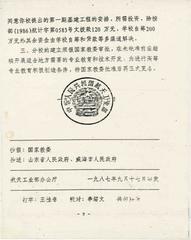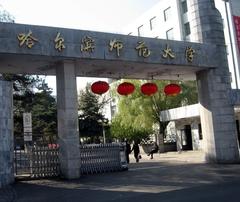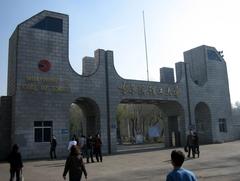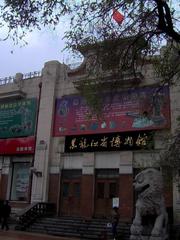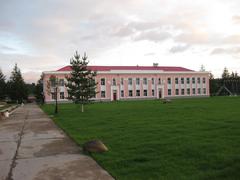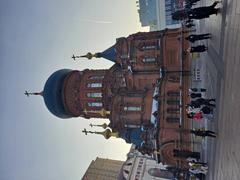
Church of the Intercession in Harbin: Visiting Hours, Tickets, and Historical Significance
Date: 04/07/2025
Introduction
The Church of the Intercession of the Mother of God in Harbin, China, is an enduring symbol of the city’s rich Russian Orthodox legacy and multicultural identity. Founded in the early 20th century amidst the construction of the China Eastern Railway, the church is a living testament to the profound cultural exchange between Russian émigrés and the Chinese community. Today, it stands as the only active Orthodox church in mainland China open to Chinese nationals, offering regular services and a unique window into Harbin’s vibrant past (Wanderboat).
Historical Background
Origins and Early Development
The origins of the Church of the Intercession trace back to a humble cemetery church and stone prayer house, established to serve the spiritual needs of Russian workers and their families during the China Eastern Railway’s construction. As the Russian community in Harbin grew, so did the demand for a larger, permanent place of worship.
Architectural Evolution
In 1930, the China Eastern Railway Administration funded the construction of the current masonry church, replacing the original wooden structure. The architecture, inspired by the Hagia Sophia Cathedral and traditional Russian Orthodox design, features an iconic onion-shaped dome, ornate iconostasis, and richly detailed frescoes. Local Chinese influences are evident in both construction materials and subtle decorative elements, reflecting Harbin’s status as a crossroads of cultures (EAA Architecture Guide).
Role in the Russian Diaspora
Following the Russian Revolution, Harbin became home to one of the world’s largest Russian communities outside the Soviet Union. The Church of the Intercession became a focal point for religious and cultural life, hosting festivals, services, and community events that preserved Russian Orthodox traditions in a foreign land (Wanderboat).
Twentieth Century Upheavals
After World War II and the founding of the People’s Republic of China, many Russians left Harbin, leading to a decline in the Orthodox congregation. Despite the challenges of the Cultural Revolution and periods of religious suppression, the church survived with much of its original architecture intact (Everything Explained Today).
Preservation and Modern Significance
Restoration efforts have protected the church’s iconic domed roof and historic interiors, and it remains a vital religious site for Harbin’s Orthodox community. Its proximity to other historic churches along “church street” makes it a key stop for those exploring Harbin’s religious and architectural heritage (Living Nomads).
Architectural Features
The church is a compact yet elegant structure, marked by a single onion dome, red brick façade with white stone trim, and tall arched windows. The interior features a classic Orthodox cruciform plan, with a richly decorated iconostasis, Byzantine-style icons, and vibrant frescoes illuminated by ornate chandeliers. The fusion of Russian Orthodox design with Chinese materials and craftsmanship gives the church a distinctly local character (EAA Architecture Guide).
Religious and Community Life
Orthodox Christianity in Harbin
Harbin’s Orthodox community has deep roots, established by Russian émigrés in the late 19th and early 20th centuries (dbpedia.org). The Church of the Intercession, sometimes called the Ukrainian Church, is now the only Orthodox church in mainland China open to Chinese nationals (Everything Explained Today).
Liturgical Life and Services
Religious services are held on Sundays, with the Typica service (generally in Chinese) at 10:00 AM. Notable events, such as the 2012 hierarchical Divine Liturgy celebrated by Metropolitan Hilarion, have marked revivals in the church’s liturgical life and reinforced its significance for the local and international Orthodox community (Serbian Orthodox Church).
Intercultural and Interfaith Dynamics
The church’s location on East Dazhi Avenue, alongside Protestant and Catholic churches, highlights Harbin’s rare religious plurality. Services are conducted in both Chinese and Church Slavonic, and the congregation includes both locals and expatriates, promoting interfaith understanding and cultural exchange (Living Nomads).
Community Impact
Despite its modest congregation, the church is a center for Orthodox worship, cultural preservation, and community gatherings. After resuming activities in 1984, the church has welcomed both local believers and international visitors, fostering connections with Russian and Chinese Orthodox clergy (Serbian Orthodox Church).
Visiting Information
Hours and Access
- Visiting Hours: Generally open Sunday mornings from 9:00 AM to 11:00 AM. The Typica service begins at 10:00 AM. Additional hours may be available; check locally.
- Tickets: Admission is free; donations are encouraged to support preservation.
- Accessibility: The area is pedestrian-friendly, and the church has some wheelchair access; however, interior mobility may be limited due to the historic structure.
- Location: 173 East Dazhi Avenue, Nangang District, Harbin. Accessible by bus or taxi from central Harbin.
Guided Tours and Tips
- Guided tours, focusing on the church’s history and architecture, are available through local agencies.
- Modest dress is recommended, and visitors should be respectful of worshippers during services.
- Photography may be restricted during liturgical celebrations; always ask permission before taking pictures.
Nearby Attractions
- Harbin Nangang Christian Church: A Gothic-style Protestant church founded by German Lutherans.
- Cathedral of the Sacred Heart of Jesus: The province’s largest Catholic church, built by Polish immigrants.
- Saint Sophia Cathedral Museum: Another iconic Russian Orthodox building, now serving as a museum.
Special Events and Photographic Opportunities
Major Orthodox feast days, such as Pascha and the Protection of the Mother of God, feature special liturgical services and draw visitors from across China and abroad. Photographers will find the church’s exterior and interior iconography particularly appealing—early morning light enhances the visual impact of the domes and façade.
Frequently Asked Questions (FAQs)
Q: What are the Church of the Intercession’s visiting hours?
A: Sundays, 9:00 AM – 11:00 AM, with service at 10:00 AM.
Q: Is there an entrance fee?
A: No, but donations are appreciated.
Q: Can tourists attend services?
A: Yes, all are welcome to observe respectfully.
Q: Is the church accessible for people with disabilities?
A: The main entrance is accessible, but some interior areas may be challenging.
Q: Are guided tours available?
A: Yes, through local tour operators.
Plan Your Visit
The Church of the Intercession is both a living place of worship and a monument to Harbin’s multicultural and religious heritage. Visitors are encouraged to attend services or guided tours to deepen their understanding of the site’s history and significance. For the most enriching experience, consider exploring the nearby religious landmarks on East Dazhi Avenue.
Visuals and Media
Include high-quality images of the church’s onion domes, vibrant walls, and interiors. Use SEO-optimized alt tags such as “Church of the Intercession Harbin visiting hours” and “Harbin historical church exterior.” Maps of East Dazhi Avenue’s religious sites and links to virtual tours further enhance the visitor experience.
Image: The Church of the Intercession’s iconic domed roof and historic façade, a must-see Harbin historical site.
Summary
The Church of the Intercession eloquently embodies Harbin’s history of religious pluralism, cultural resilience, and architectural beauty. Its ongoing role as a functioning Orthodox church, combined with its historical and architectural significance, makes it an essential destination for anyone exploring Harbin’s unique heritage (EAA Architecture Guide). Visitors can enrich their experience by attending services, joining guided tours, and exploring the vibrant “church street” atmosphere of East Dazhi Avenue (Everything Explained Today).
For travel updates, audio guides, and curated experiences, download the Audiala app and follow local cultural heritage platforms.
Sources and Further Reading
- Discover the Church of the Intercession in Harbin, 2024, Wanderboat (Wanderboat)
- Architectural Features and Visiting Guide to the Church of the Intercession in Harbin, 2024, EAA Architecture Guide (EAA Architecture Guide)
- Visiting the Church of the Intercession in Harbin: History, Services, and Visitor Information, 2024, Everything Explained Today (Everything Explained Today)
- Visiting the Church of the Intercession in Harbin: Hours, Tickets, and Historical Significance, 2024, Living Nomads (Living Nomads)
- Hierarchical Liturgy Celebrated at Church of the Intercession in Harbin, 2012, Serbian Orthodox Church (Serbian Orthodox Church)








